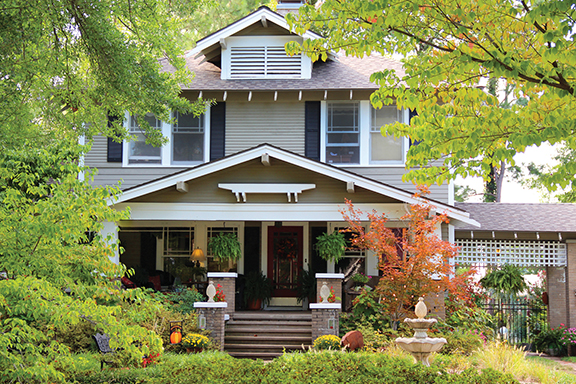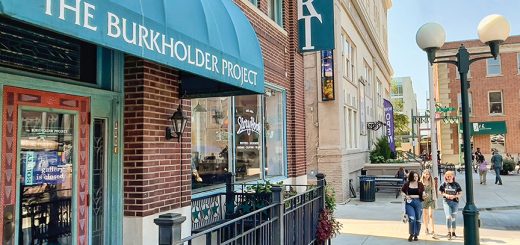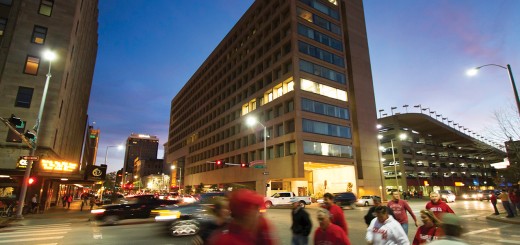Neighborhoods

Lincoln is home to a wide variety of people—young families, college students, new Americans, workers, professionals and entrepreneurs—and there is a neighborhood for everyone. Whether you’re visiting Lincoln or living here full time, the city’s neighborhoods offer plenty to explore.
There are more than 45 neighborhoods in Lincoln—and new ones are being planned and built as this is being written. These are just a few of them. Contact information for all of Lincoln’s neighborhood or voluntary homeowners’ associations are listed at www.lincoln.ne.gov/cIty/urban/neighborhoods/index.htm.
Country Club
Statuesque trees and elegant homes define the Country Club neighborhood. This area grew after the Country Club of Lincoln was built on South 24th Street in 1903. It still stands today, and includes their beautiful golf course as a point of pride for its members and nearby residents. For information on the Country Club Neighborhood Association, visit www.ccnalinc.org/.
College View
The College View neighborhood, located along 48th near Calvert Street, grew up around Union College. Union College is a Seventh-Day Adventist school built in the early 1900s on the highest elevation in Lincoln. When it was built, the city agreed to build a trolley line to the college from downtown Lincoln and for a time the new college campus became a destination for family outings. This charming area has an attractive mix of small businesses that reflects its past as a separate village. The many single-family homes and Union College student apartments make the neighborhood a smaller, college town within the city. For more information visit www.facebook.com/college.view.nebraska.
Near South
The Near South neighborhood is one of the oldest areas in the city and features a number of grand old homes of historical and architectural significance. Close to downtown, this neighborhood holds single-family dwellings, both large and small, and eclectic, converted apartments popular with young adults and college students. Some of Lincoln’s bed and breakfasts are in this area as well. They offer a quiet, charming alternative to the city’s larger hotels. This neighborhood is located between G and South Streets, from 13th to 27th Street.
A popular spot for youth in the area is the F Street Community Center, found in the northwest corner of the neighborhood. The facility offers many youth and adult programs, pick-up basketball games, weight machines, book clubs and cooking classes. For more information visit www.nearsouth.org.
Arnold Heights
In far northwest Lincoln, Arnold Heights, popularly known as Airpark, originally began as housing for the Lincoln Air Force Base. When the base closed in 1966, the area was annexed by Lincoln. The neighborhood continues to be developed with the addition of more duplexes and single-family homes. The public pool is a well-liked destination on a hot summer day, and the population rises significantly whenever an air show is in town.
North Bottoms
The North Bottoms, also known as the Russian Bottoms, was originally settled by Volga-German refugees from Russia. It’s directly north of the University of Nebraska-Lincoln downtown campus, and many of it’s small houses are now rented by students. Now new student housing complexes are also being built in this neighborhood. Some of the city’s oldest parks are in this area. To learn more about these first residents, visit the Germans from Russia Museum located in the South Bottoms neighborhood, south of the Haymarket district.
Havelock
Havelock began as a separate village in the 1880s and was home to a Burlington Railroad locomotive assembly and repair shop as well as an aircraft manufacturer. It was annexed by Lincoln in the 1930s. Located in the northeast, along Havelock Avenue, it’s home to the original Misty’s steakhouse, Havelock Furniture, and the Joyo Theatre. The Joyo is an old-fashioned theatre enjoying a new life with second-run movies, cult films and movies for kids. The area has a truly homey small-town feel, with many opportunities to get out and mingle with your neighbors, such as the popular weekly farmers market. For more information visit havelock-ne.blogspot.com.
University Place
University Place, located along 48th Street between Leighton Avenue and Adams Street, inherited its name from the historic Nebraska Wesleyan University. The neighborhood also offers a number of parks, a swimming pool, a farmers market and other recreational activities. Small businesses dot the side of 48th Street in the commercial district, where you can find an assortment of small specialty shops and favorite local eateries. They also hold a farmers market on Wednesdays for most of the summer. University Place is also the home of the Lux Art Center, a community art gallery and shop that offers a variety of art classes for children and adults. Visit upcolincoln.org for more information on this community.
Belmont
Belmont is located just north of Cornhusker Highway and south of Superior Street. Its close location to Interstate I-80 makes this neighborhood ideal for commuters. The local recreation center also offers a number of programs, from summer day camps for youth, to table tennis and a gym.
Capitol Beach
Summer cabins and year round homes surround the private Capitol Beach Lake, north of West O Street and just west of downtown. For decades, the area was Lincoln’s first amusement park, with a wooden roller coaster, steamboat rides, a funhouse and bumper cars. Now the area boasts picturesque lakeside homes and condos with a view. Summer or winter, Capitol Beach is a beautiful location.
Lincoln truly is a big city with a small town feel. Each neighborhood brings its own unique advantages and personality, adding up to a unified community. Together, all the neighborhoods work to make Lincoln come alive.














Recent Comments